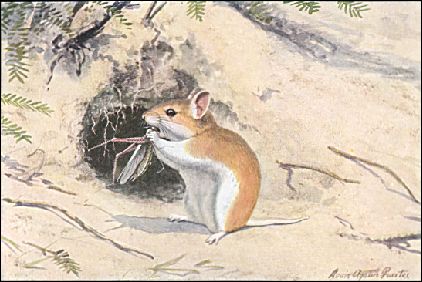

A snout lifted to the sky, a drawn-out howl drifting across the darkness of the Chihuahuan Desert night. The call of the wild—miniaturized version. In this case, it's not a wolf proclaiming its kingdom, but a grasshopper mouse.
Mice howling like wolves? Yes, but you have to scale it down to mouse size, resulting in a mouse-sized volume and a pitch almost too high to hear. Now, we usually don't think of mice as flesh-eaters, though if the truth be known, most will be so if given an opportunity. The grasshopper mice, though, are much more predatory than most, and a snack of insect parts or mouse brain is right down their alley.
Mammalogists sometimes use snap traps laid across the countryside to
collect specimens for scientific study. Many a mammalogist has given way to
inappropriate language upon finding his trap line has already been run and his captured
specimens in perfect condition—except for chewed-away craniums devoid of brains. Well
might the mighty mouse howl, filled to satisfaction with bounty twice appreciated
because unearned.

Contributor: Arthur H. Harris, Laboratory for Environmental Biology, Centennial Museum, University of Texas at El Paso.
<<p class="three"> Desert Diary is a joint production of the Centennial Museum and KTEP National Public Radio at the University of Texas at El Paso.
Painting of Onychomys leucogaster by Louis Agassiz Fuertes. After Nelson, 1918.